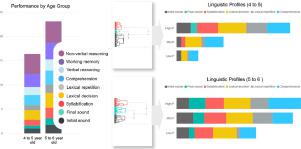Early Childhood Research Quarterly ( IF 3.2 ) Pub Date : 2022-03-10 , DOI: 10.1016/j.ecresq.2022.01.005 Yeniè S. Norambuena , Katia L. Sáez , Darío Fuentes , Fernando P. Ponce , Gonzalo Salas

|
The aim of the present study was to compare emergent literacy profiles among Spanish-speaking preschoolers with and without developmental language disorders (DLD), based on phonological and lexical skills, working memory (WM), and analogical reasoning (AR, including verbal and nonverbal). The study sample was composed of 123 children aged 47- 62 months (age group 1 or G1:M = 55.09, SD = 4.52; 61 boys, 62 girls) and 115 children aged 63–78 months (age group 2 or G2:M = 69.27, SD = 4.16; 54 boys, 61 girls). We compared the performance by age group in all measures, after which hierarchical cluster analyses using emergent literacy scores were performed for each age group. The linguistic and cognitive factors of the resulting clusters were compared using the Kruskal-Wallis test and pairwise comparison. Cluster analysis yielded 3 clusters in each age group that significantly differed on linguistic and cognitive measures. The groups were identified as high, mid, and low performance. DLD groups were associated with low performance in listening comprehension, lexical decision, and syllabification in G1 and lexical repetition and final sound in G2. The high-performance groups were associated with higher performance in syllabification, initial sound, and lexical repetition in G1 and listening comprehension in G2. The main differences between age groups were observed in syllabification and lexical decision. Furthermore, the results suggest that verbal AR and WM are positive markers of linguistic profiles in the youngest group, while only verbal AR appears relevant in the oldest group. These findings highlight the heterogeneity of emergent literacy profiles and may enhance the understanding of language and literacy development in typical and DLD Spanish-speaking children.
中文翻译:

新兴识字期的语言、类比推理和工作记忆技能:通过聚类分析的典型和 DLD 轨迹
本研究的目的是根据语音和词汇技能、工作记忆 (WM) 和类比推理 (AR,包括语言和非语言)。研究样本由 123 名 47-62 个月的儿童(年龄组 1 或 G1:M = 55.09,SD = 4.52;61 名男孩,62 名女孩)和 115 名年龄在 63-78 个月的儿童(年龄组 2 或 G2:M = 69.27,标准差 = 4.16;54 名男孩,61 名女孩)。我们比较了各年龄组在所有测量中的表现,然后对每个年龄组使用紧急识字分数进行分层聚类分析。使用 Kruskal-Wallis 检验和成对比较来比较所得聚类的语言和认知因素。聚类分析在每个年龄组中产生了 3 个聚类,这些聚类在语言和认知测量方面存在显着差异。这些组被确定为高、中、低绩效。DLD 组与 G1 中的听力理解、词汇决定和音节化以及 G2 中的词汇重复和最终声音的低表现有关。高绩效组与 G1 中音节化、初始声音和词汇重复以及 G2 中听力理解的更高表现相关。在音节和词汇决定方面观察到年龄组之间的主要差异。此外,结果表明,语言 AR 和 WM 是最年轻组语言特征的积极标记,而只有语言 AR 似乎与最年长组相关。这些发现突出了新兴读写能力的异质性,并可能增强对典型和 DLD 西班牙语儿童的语言和读写能力发展的理解。









































 京公网安备 11010802027423号
京公网安备 11010802027423号